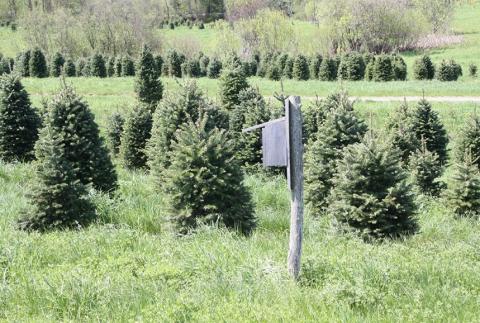Bringing Nature Home: Picking Out Your Christmas Tree

The holiday season is upon us, and for many families it’s time to think about getting a Christmas tree. Choosing a tree can be a cherished family tradition and a great way to spend some time outdoors. Growing up in Boston, a big part of my childhood Christmas was going with my Dad to choose a tree. We’d bring it home, and my Mom (having taken the considerable time to untangle all of the lights from last year), would have them out with the ornaments and ready to hang. It still makes me smile when I think about being a child and I reflect on the joy that I felt when we set up the Christmas tree.
In NH we have over 200 growers producing Christmas trees. This industry generates nearly $ 4 million annually. In addition to the economic value of our Christmas tree industry, these farms also contribute to the scenic beauty of our state. During the ten or more years they take to grow, Christmas trees cleanse the air, provide us with oxygen, protect our water, and provide homes for wildlife.
Years ago, I told a friend (and Christmas tree grower) that I felt guilty going out to cut down a beautiful tree to enjoy inside for such a short period of time. She replied that these trees are grown as crops – just like a head of lettuce. She then asked me if I felt guilty about harvesting lettuce. “It’s the same thing”, she said. And for each tree harvested, several seedlings are planted the next spring to continue the crop.
Balsam and fraser fir are the most popular Christmas tree species with their fragrant, soft, flat blue green needles. Concolor fir is becoming a more popular Christmas tree with its longer needles (up to 3” in length) and citrus fragrance. Colorado blue spruce, and white pine are a few other species you may find.
Quality trees, regardless of species, have been sheared and cared for anywhere from eight to twelve years. The shape and fullness of the tree is generally a result of dedicated annual work to produce a quality product. The open-grown Christmas trees with large spaces between the branches that many of us remember from our youth have been replaced by these well-tended, full trees.
Once you have chosen your tree, you should keep it in a cool location until you are ready to set it up in your home. When you are ready to bring the tree inside, make a fresh butt cut removing about an inch of wood from the base of the stem. This will ensure greater initial uptake of water. Historical research has shown that additives to the water have had little if any benefit to the tree. Be sure and place your tree in the proper stand size and make sure the water level is checked daily. Placing your tree a safe distance from any fireplace, wood stove or other heat source is critical to minimize any fire hazard and to extend the life of your tree throughout the holiday season.
Christmas trees and pets raise some interesting challenges – over the years I have lost many ornaments and have had to pick up my tree numerous times as my cats have gotten too inquisitive. Sometimes I feel like I am staking a tent to withstand high winds as I try to stabilize my tree from the onslaught of interested felines!
I no longer use tinsel because my cats try to eat it. I was fortunate that I caught them early on as tinsel can cause a blockage in your pets’ intestines and require surgery. Eating pine (fir and spruce) needles can also cause irritation and discomfort for your pets.
Wendy Scribner is a Natural Resources Field Specialist with UNH Cooperative Extension in Carroll County. For more information please call (603) 447-3834 or email wendy.scribner@unh.edu.
